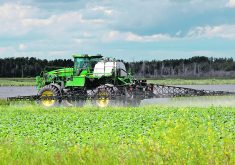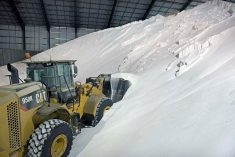With any luck, farmers will be blessed with average weather and normal field conditions this year.
If prices and demand hold up, farmers don’t need more than an average crop to reap a great return.
If farmers are so blessed, they’ll have some pleasant but tough decisions about where to put their profits.
For those needing to rebuild balance sheets ravaged by multiple years of drought or other problems, it won’t be too hard to figure out what to do with the money. It should be good at filling some holes.
Read Also

Critical growing season is ahead for soybeans
What the weather turns out to be in the United States is going to have a significant impact on Canadian producers’ prices
But for those who managed to get OK crops last year and the year before, or got enough of a crop and sold it at high enough prices to eke out marginal returns, there should be more choices. Those are going to present more challenges than usual.
If farmers buy stuff — iron, systems, technology — they will probably find that stuff is costing more than it did a few months ago.
This inflation is no small deal for manufacturers and service providers. Commodities like steel and energy are way up in price, sophisticated components like semiconductors are up in price and often unavailable, and labour is scarce and rusty. That all leads to higher prices for most things.
If farmers don’t want to bury their profits in stuff, they’ve got some conservative options that offer security after these last couple of hair-raising years.
Farmers can pay down debt or build up working capital if decent crops bring decent money. That doesn’t sound fun, but with interest rates beginning what could be a multi-year climb, chopping or avoiding debt might be the smartest thing anybody can do with spare cash.
“If we have a really good crop this year… and you get good returns this year, in a rising interest rate environment it’s a great time to consider paying down debt,” Farm Credit Canada senior economist Craig Klemmer told me.
But with almost everything costing more these days and some inputs soaring in price, keeping free cash around is also essential.
“Ensuring you have really good working capital is going to be important going into next year,” said Klemmer.
That doesn’t mean farmers should be scared of investing in their farms as well as their balance sheets. Interest rates might be marching higher, but they’re still far below what used to be normal or average.
“Interest rates are going up, but they’re still historically cheap,” said Klemmer.
High fertilizer and fuel prices are stealing some of the joy out of farm finances these days. Equipment and technology purchases are also likely to furrow many brows. But it’s better to be paying high prices when you’re earning good money.
How long this particular set of conditions persists is a big question in markets today. Some think the impact of the commodity price inflation will cause a global recession and therefore suppress interest rate increases. Others predict ever increasing pressure on prices from the already small stocks of most commodities and the extreme disruptions being wrought by the Russian invasion of Ukraine and western sanctions on Russia.
Crop prices can move fast and they have. Interest rates move slowly but tend to follow inexorable trends. Both are now on the move, but nobody should assume the two will march in lockstep.
That means farmers’ decisions about what to do with their profits this year will have to take those factors into account.
But if farmers manage to pull off an average crop this year, the decisions they make should be easier to swallow than the decisions made this winter by those in drought-stricken areas.


















